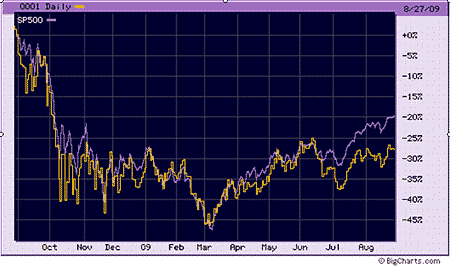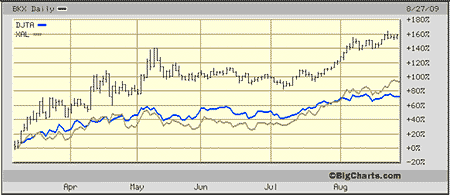Before I do anything else, I want to let you know that I’ve just put the finishing touches to a new report on my favourite gold stocks.
Now, on to today’s topic.
Not unlike the Ashes series, leadership in the stock market has ebbed and flowed dramatically this year.
For a few months one sector has led, but then another has taken over. It shows the rapidly changing attitude and sentiment amongst investors and speculators.
In short, no one seems to have a clue where the market’s going next…
Using the S&P 500 as a barometer for global stock markets, we see that the US market made its first low on October 27th, 2008. It then made a lower low on November 20th and then its final low occurred on March 6th, 2009. Since that March 6th low of 666 we have rallied some 55% to 1,030.

However, no single sector has led the market higher during that period.
Gold stocks were the first to rise from the ashes. They made their final low on October 27, 2008. On November 20 they made a higher low and by mid-February they had doubled. From a low around 150 the HUI (the index of unhedged major gold producers) went from 150 to 330, and at the end of May, it nearly hit 400.
However, it has been in a slight downtrend ever since. Now at 359, it is just a few points higher than its February high of 330. Over the summer it has simply meandered along and has been significantly outperformed by the S&P 500.
The next sector to take off was commodities. These stocks did well in the rally from March to early June, particularly industrial metals and oil. But this is another sector that seems to have rolled over. The purple line on the chart below shows the S&P 500, while the yellow shows the Dow Jones oil and gas index.

Despite the oil price itself making marginally higher highs, the oil stocks have been unable to break through their June high, while the S&P 500 has comfortably surpassed it. From a chartist’s point of view, lower highs are not a good sign – they tend to point to further falls.
So what took over next? Well, since the brief June/July correction, the stock market has been led to fresh highs, not by gold or energy, but by banking stocks and airlines. This black line on the chart below shows BKX, the exchange-traded fund (ETF) which tracks the banking sector; the yellow line shows the airline sector; and the blue line shows the transports, another sector which has done well.

We can see that stock market leadership has changed with each fresh surge. It seems that as investors have gradually gained confidence in the global recovery story, they have slowly increased their exposure to trashier assets. Gold stocks recovered first, as the best-placed to benefit from demand for gold in riskier times. Then commodities resurged on the back of hopes that Asia would drag the economy from the mire. Now that the bulls are firmly in charge, all the stocks that suffer the most in a downturn – banking, airlines – are being snapped up in the hope that the recovery turns out to be V-shaped and their profits make a rapid return to health.
Of course, there will be some kind of correction at some stage – you don’t get rallies of this size without the occasional pause for breath at least. The big questions is – how big will it be? More than a few pundits are predicting another fall this autumn of similar levels to the one we saw last year. Regular readers will know that I for one, have been looking for further falls. And I’ll admit freely, this rally has me now doubting my convictions.
But perhaps that’s a sign that the bear market rally is doing just what bear rallies are meant to – sucking all the scepticism out of the market before dumping investors on their backsides again. And certainly, despite the caution among some commentators, investor sentiment has become very positive – almost too positive. The Investors Intelligence Advisors Sentiment index, which gauges the advice of about 150 newsletters and other paid market-advice outlets, on Wednesday said the portion of bullish stock advisers had jumped to 51.6% in the past week, the highest seen since December 2007. The proportion of bears fell to 19.8%, the first time since October 2007 that the percentage fell below 20%. (and we all know what happened next). Many traders look for a break of 20% as a signal to go short (to bet on the market falling).
Where is the market going next?
So what will happen next? I do see just above 1,100 on the S&P 500 as a major turning point. That is the mark at which we will have retraced 50% of the falls from the October 2007 highs, to the March 2009 lows. There’ll be a lot of resistance here, and the market could easily roll over. What’s more, the seasonal pattern of post-election years also points to September falls.
But just as Japan’s Nikkei index had a sustained bear market rally of more than a year between 1999 and 2000, after the Asian crisis, it’s possible that this rally in the Western indices could continue longer than anyone expects – perhaps even into 2010 – and go much higher than anyone expects.
So what can an investor do? Well, my colleagues at MoneyWeek have been tipping defensive stocks as a core holding for several months now. These stocks have been among the worst-performing during the rally. In the past six months, the worst-performing sectors have been two of the most defensive – electricity (down 7%) and water (down 4.5%).
So from a contrarian perspective, there can be few better bets at the moment. This way you get to hedge your bets – if the market falls further, defensives won’t suffer much, and you’ve still by and large got tasty dividend yields to compensate. And if the market continues to rise, then its likely that leadership will shift again to laggards as investors look for stocks that haven’t been caught up in the recovery rally yet.
Why now could be a good time to buy gold stocks
As for those who are tempted to invest somewhere a bit more spicy – this may not surprise you, but I’d suggest looking at gold stocks. As noted above, after their initial recovery, they’ve lagged the market over the summer. But to my mind, that makes now a good time to increase your exposure to the sector ahead of the next surge – if you haven’t already done so.
Category: Investing in Gold

